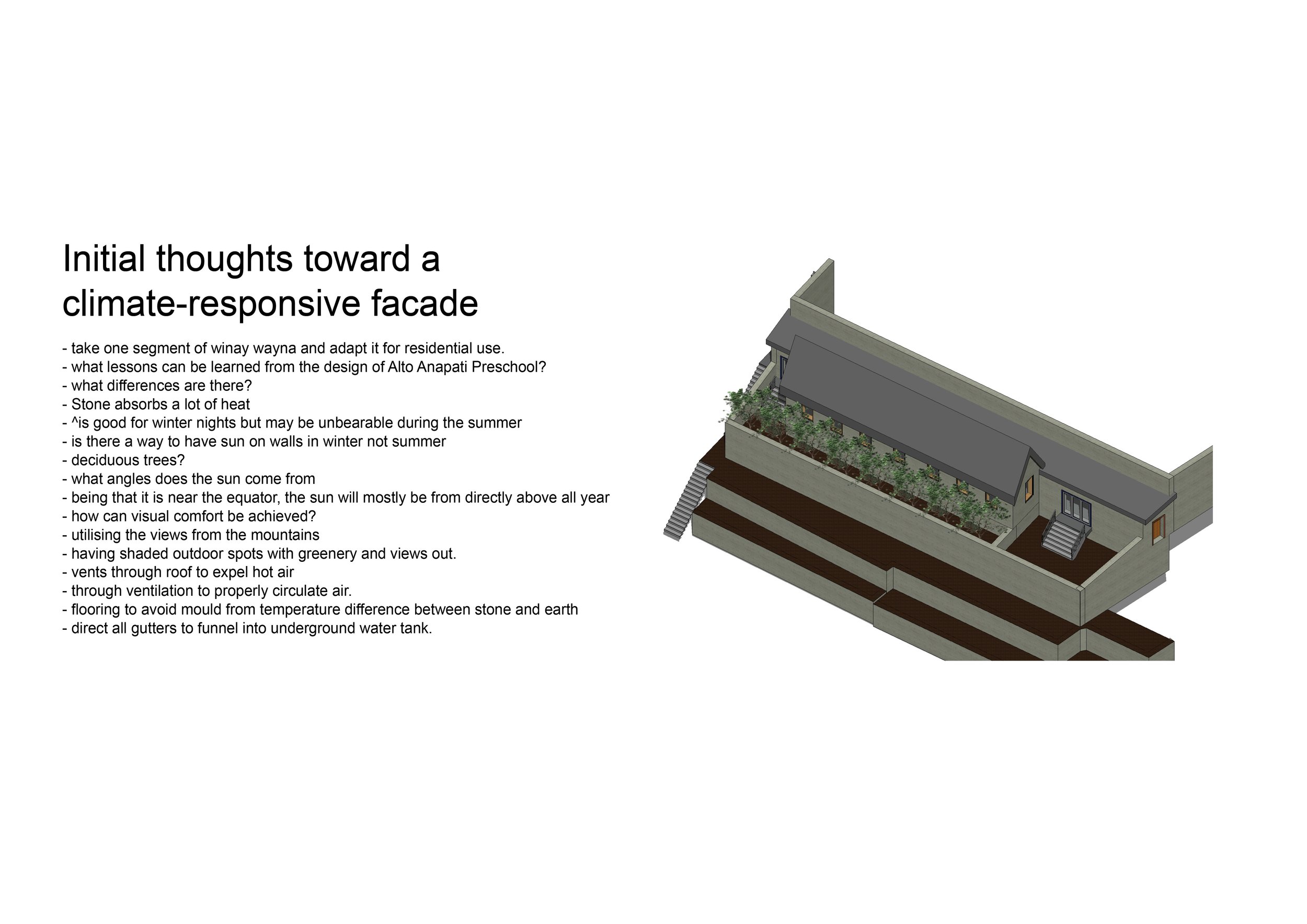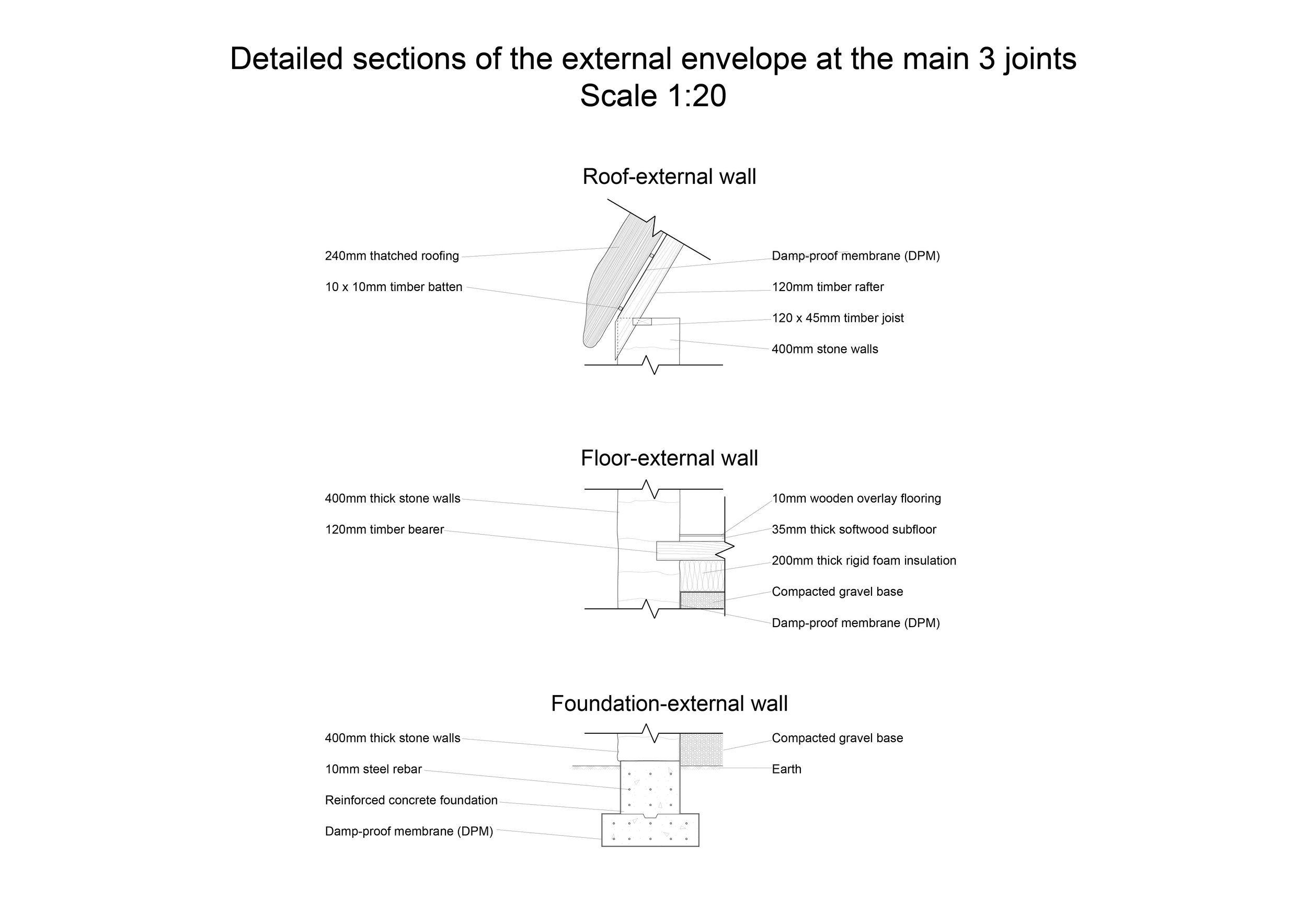Wiñay Wayna
Masters Tech Project
A reimagining of vernacular Peruvian architecture to address the site-specific climate conditions. This involved designing around existing features whilst also creating new detailed sections of key joints.




With a rich history from the Incan Empire to European colonisation by Spanish settlers, a variety of building techniques are present to deal with Peru’s various unique climatic and geographic challenges. Responding to Peru’s three different climate regions (coastland, Andes, Amazon) takes different approaches, so buildings in one region are unlikely to be similar to another region if the climate is factored in. Earthquakes are also more prevalent in some regions given proximity to fault lines so the severity of how this affects designs is variable.
Wiñay Wayna is located in the Andean Highlands of Peru. Thought to be a resting place for travellers heading to Machu Picchu, the ruins were also speculated to be a “fortress, a look-out point, an agricultural site as well as a religious temple.” (Bustamante, 2021)
The use of the contours of the land and local materials were a cornerstone of Incan Architecture, especially when building in the Andes with its' increased rainfall. In a heavily earthquake prone country, the intricate stonework is testament to the Inca’s ability to build strong and firm structures. The use of the contours of the land and local materials were a cornerstone of Incan Architecture, especially when building in the Andes with its' increased rainfall. In a heavily earthquake prone country, the intricate stonework is testament to the Inca’s ability to build strong and firm structures.
This region is known to be cool and dry almost all year round but has days with up to 10 sunshine hours and receives an average of 105 rainfall days per annum. Adapting a section of Wiñay Wayna for the purpose of housing creates several obstacles. For a start, there is no roof, windows or flooring to the structure. As the final camp on the Inca trail before reaching Machu Picchu, these buildings are 3680 metres above sea level.
It is important, due to its lack of proximity to towns or other infrastructure, to capture rainwater and make the greatest use out of it. With the bathroom and kitchen being in the centre of the building, the gutters are angled inward and are used to fill water tanks that sit underneath the centre of the building. This water can be filtered and used for showers and consumption, with run off being used for the greywater in the toilet and for watering plants. Stone has a high capacity to absorb and store heat. While this can be helpful during colder winter months, this could result in temperatures being too intense during the summer. To combat this, deciduous trees have been planted along the northern façade of the building. This shades the stone walls during summer months keeping interior temperatures down, but unlike with evergreens, deciduous trees lose their leaves in winter months. By exposing these walls to sun, they will absorb more heat which they can dissipate during colder winter nights. Currently at Wiñay Wayna, the internal flooring is just exposed dirt. This does give the opportunity for earth cooling, a process by which cooler air is provided at night as earth does not absorb a great deal of heat during the day so does not dissipate as much during the night. This is particularly important during the hot summer months. Earth is also a porous surface. Water is easily soaked up into the ground without much runoff. Unfortunately, this creates an issue between the potential different surface temperatures of the stone and the earth as they come into contact as well as the moisture content within the building. As moisture evaporates out of the ground, it can settle on the stone walls. When these stone walls get colder, there is the likelihood that any dust and moisture that has settled on them, will start to grow mould. To avoid this, a damp-proof membrane (DPM) should be wrapped around the foundations and a layer of underfloor insulation provided between the earth and new interior flooring. Ventilation is another important strategy to improve Wiñay Wayna. With a newly sealed building envelope, air quality becomes an issue, and to combat this, the ventilation needs to be adequate. Utilising the doors on the southern edge of the building, through ventilation can be achieved, circulating air through the entire length of the building. Another way to improve the air quality is through openable vents in the roof. These create the opportunity to expel hot damp air out of the roof via convection currents (hot air rises and cold air sinks due to differences in air density). Being so close to the equator means that Wiñay Wayna actually has the sun coming from the North in the Winter months but from the South during Summer months. This is due to the Earth’s axial tilt which is the reason for seasons. The axis that Earth spins on is not parallel to our orbit of the sun which means that the equator is not always the most exposed to sunlight, this can vary either side of the equator. The Northern Hemisphere experiences summer when the North Pole is closer to the Sun and the Southern Hemisphere experiencing summer when the South Pole is closer. With Peru’s proximity to the Equator, the Sun’s position relative to the country flips at the peak of summer and now comes from the South. This means that for most of the summer, the Wiñay Wayna site is being hit from above, and the best way to protect from overexposure to heat, is with a well-insulated roof with ventilation to release hotter air from the building.
